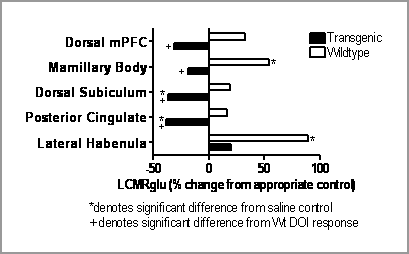Print version
Search Pub Med
Altered cerebral glucose metabolism in the response to doi in serotonin transporter over-expressing mice Genetic variation leading to altered serotonin transporter (SERT) expression is a predisposing factor in mood disorders (Pezawas et al., 2005). Previous studies have used a novel strain of genetically engineered mice, which over-express human SERT (Jennings et al., 2003), to explore the role of the transporter in determining serotonergic neuronal function. In this study we have used the same transgenic strain and applied the 2-deoxyglucose autoradiographic imaging technique to further investigate altered postsynaptic 5-HT 2 receptor function in these animals when challenged with DOI. Wild-type and transgenic, CBAxC57Bl6, male mice (27g-39g) were injected i.p. with DOI (25mg.kg-1, n = 7 from each genotype) or saline (wild-type, n = 11; transgenic, n = 12). Local cerebral glucose utilisation (LCMRglu) was measured 15 min. later by semi-quantitative [14C]-2-deoxyglucose autoradiography in 48 brain regions of interest (ROI) (Kelly, et al. 2002) . Data (mean ± s.e.m) were analysed using t-test with Bonferroni correction (p<0.05). Following acute saline there was no significant difference in LCMRglu, in any of the 48 ROI observed, between wild-type and transgenic animals. In wild type animals DOI produced widespread increases in LCMRglu (range 11% to 89%), which because of high intrinsic variability were significantly different from control in only 6 of the 48 regions analysed. In contrast, there was no evidence for increased LCMRglu in DOI-treated transgenic mice. Indeed, in 5 brain regions DOI produced significant decreases in LCMRglu. Only one region, the lateral habenula, showed a non-significant increase in LCMRglu (20%). Following DOI, LCMRglu was consistently lower in transgenic animals when compared to wild type animals in every ROI analysed (range -22% to -50%), and was significantly lower in 15 of the 48 ROI observed.
These results suggest that a life-long increase in SERT expression alters the normal functional response of the endogenous serotonin systems to the 5-HT2 agonist DOI. A decrease in 5-HT2 functional activity is suggested, as LCMRglu alterations are attenuated, in SERT over-expressing mice.
Jennings , K. et al. (2003) Br. J. Pharmacol. 138, 176P. This work was funded by EC Grant LSHM-CT-2004-503474. |
|


